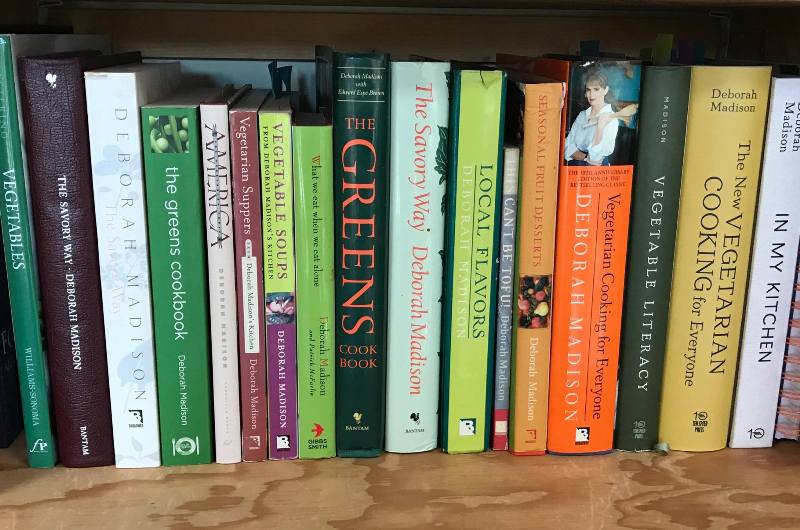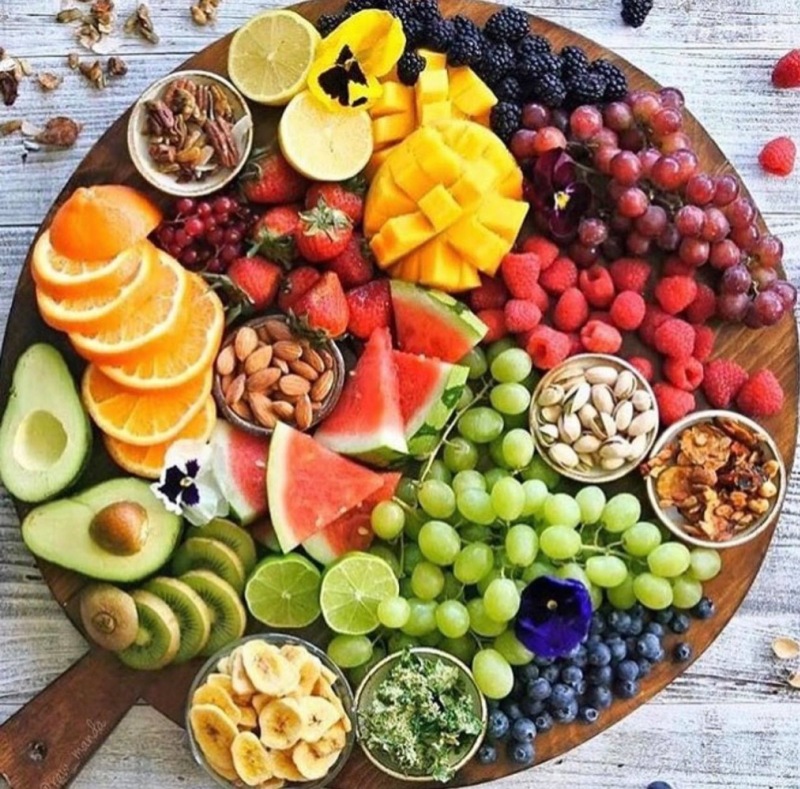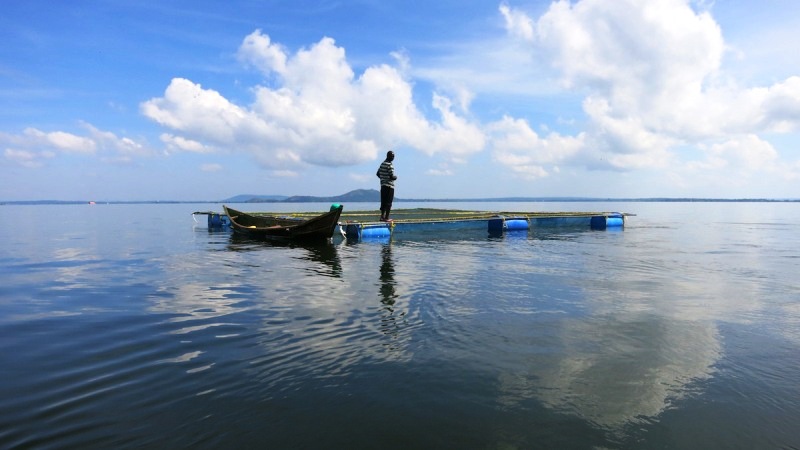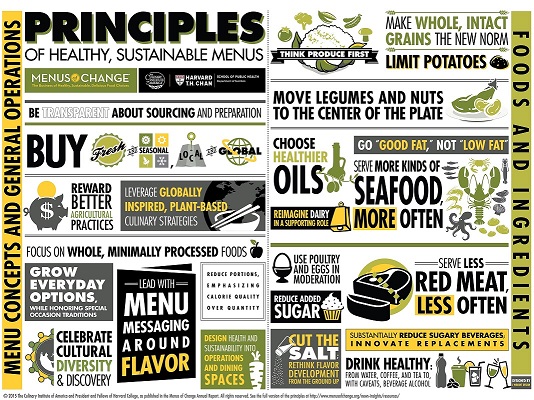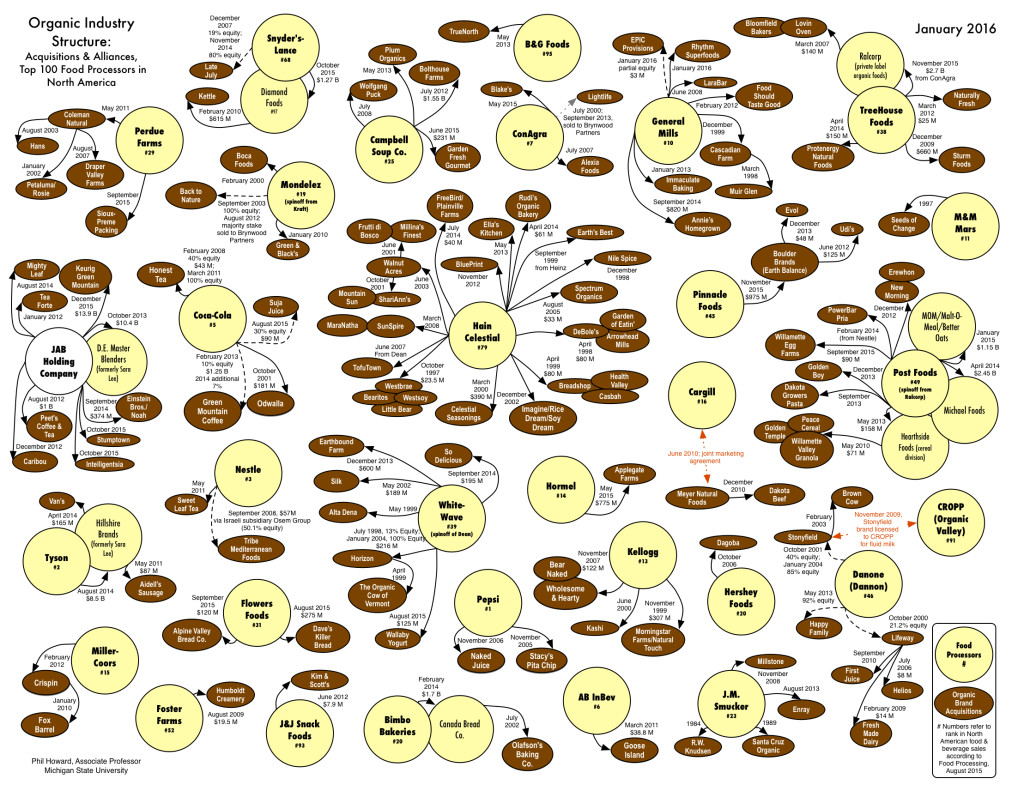Food Pages: On Earth Food Politics
Think seasonal, sustainable, local and healthy
Yes, we at GreenPolicy360 for many, many years have joined with the food revolution
Deborah Madison in Santa Fe, with her green kitchen, helped show us the farm-to-table way
We are all citizens of the world -- José Andrés (@chefjoseandres), WORLD CENTRAL KITCHEN
Every day at work, World Kitchen has served 400 million chef-prepared meals to communities impacted by natural disasters and during humanitarian crises
SJS / GreenPolicy360 Siterunner:
Michael Pollan was a friend of ours, at Bioneers and Seeds of Change in Santa Fe in the early 90s. Seeds of Change was becoming a new voice, a farm, a healthy food company pioneering what was becoming known as a New American diet, a green kitchen, organic recipes, and we were working alongside chefs Alice Waters and Deborah Madison. We were also evangelists for what came to be called farm-to-table and market gardening practices. A new food movement was being created and Michael Pollan was one of those who understood.
We brought and exchanged ideas about food diversity ('pollinating', yes) and the underlying importance of diversity of seed stock in 'alternative agriculture', heirloom seeds, the seeds selected and saved for their best of season qualities and grown out to be planted over the decades and centuries, became the theme. Plant biodiversity is, as we used to say, is "nature's strategy of survival". The multiple varieties of edibles contrast with the selection of a few varieties that comprise industrial "monoculture". The diversity of plant and food varieties begins with what are often called "heirloom" seeds and traditional seeds as opposed to the hybrid, patented seeds and planting regimens with high petrochemical inputs of industrial agriculture.
Michael Pollan's The Seed Conspiracy is revealing in telling this story and his writing which we provided research resources has, in many ways, helped to spread awareness and a food revolution in the US. Read Michael's 1994 long-form 'Seed Conspiracy' article for NY Times Magazine. It becomes a basis and exploratory source for his many subsequent books. Our work and Michael's on organic ag, independent agricultural practices (see the listing that follows) has truly over decades now shaped food, diet, restaurants and how restaurants succeed, and all the health benefits that are being learned everyday. The food revolution has become reality.
So, feast your eyes on this as a starter...
Photo from Stacey Hotchkin Robinson, M.D.
St. Petersburg, Florida - Author of Road Map to Health
* https://www.amazon.com/Road-Map-Health-Steps-Destination/dp/0692527729
🥬
Skip the Animal Meat, the Livestock, the Cattle Yards, the Huge Feeding Lots, the Health Impacts, Environmental, Health, and Medical Damage.... think of Alternatives
Not Meat Has Arrived
From ethics to environmental responsibility, meat grown in a lab has more advantages to offer than any other food innovation in recent memory
By Marni Soupcoff / Opinion / Courtesy of National Post - Canada
Dec 04, 2020
In a move that is being hailed as a major turning point for the food industry, regulators in Singapore have become the first in the world to approve the sale of no-kill, lab-grown meat. But what if consumers are too grossed out by the idea of chicken cells grown in bioreactors to make the development the watershed it should be?
'Granted, contemplating chicken nuggets that began their existence as cells taken from biopsies of live animals, and were then grown in a medium of fetal bovine serum, is not especially appetizing. But then neither is thinking about slaughterhouses where two-month-old factory-farmed chickens are hung by their necks on assembly lines to have their throats sliced by machines.
It seems that Eat Just, the San Francisco-based startup that makes the cultured “chicken bites” Singapore has now deemed safe, is at the minimum offering an alternative that is no more repulsive than the status quo.
Cultured meat has the potential to be better than “regular” meat in many ways, and though few people will care about all the benefits, most people will be moved by at least one of them. How could an animal lover’s heart not be warmed by sitting down to a steak dinner where it could be accurately announced that, “No cows were harmed in the making of this meal”?
Anyone who worries about the suffering animals endure while being industrial-farmed and killed for food must appreciate a system that eliminates the industrial-farming and killing. And if they do not, they are probably letting the perfect be the enemy of the good.
It sounds unnatural to create meat from a cell bank. Maybe it is. Yet there is probably no better way to protect nature.
Environmentalists ought to be keen on all the land, energy and water that could be saved by cultivating meat rather than farming animals, especially in the case of beef, which normally requires 14,982 litres of water per kilogram to get it from pasture to plate (or beef to burger, depending on your preferred alliteration).
Similarly, cultured meat should eventually drastically reduce the air and water pollution caused by livestock. A factory farm can easily generate millions of litres of animal waste a year, while a bioreactor generates none. Once scaled up, cultured meat production will create far fewer CO2 emissions than animal farming, as well.
Traditional meat production has led to antibiotic resistance in many livestock. It was bound to happen, as roughly three times more antibiotics are used in farm animals than in people. When meat is created in a lab, there are no antibiotics (and therefore no superbugs) to worry about. Similarly, while cows get fed growth hormones, cow cells do not, which eliminates the need to worry about the health impact that such additives have on meat-eating humans (which are currently unclear).
As recently as 2013, lab-grown meat was making headlines as a bizarre, futuristic curiosity. In a research project funded by Google co-founder Sergei Brin at the time, it took two years and US$325,000 ($418,000) for Dutch scientists to come up with a single “test tube” hamburger. In an exhibition the New York Times characterized as “an odd demonstration of one view of the future of food,” a chef fried up the novel lab-made patty, which was grown from cow muscle cells, and volunteers tasted it, with the whole show broadcast live to the world via a flashy live stream.
Mark Post, one of the creators of that first no-kill burger, said then that much research remained to be done. He predicted that it would take a decade or more before cultured meat became commercially feasible. So we should not underestimate how extraordinary it is that only seven years later, we are now looking at lab-grown chicken nuggets primed to hit the market in Singapore. Human ingenuity can be a beautiful thing to behold and the only obstacle that threatens to hold it back is human trepidation about anything new and different.
Let us hope reason prevails over suspicion of the unknown when it comes to cultured meat. Because helping ensure everyone on earth has enough to eat would, in itself, be reason enough to support this — test-tube meat is a boon for food security. But from ethics to environmental responsibility, meat grown in a lab has more advantages to offer than any other food innovation in recent memory.
🫶
Ken Benway: Here's a wonderful poem written by Felix Akicho from Homa Bay in Kenya Africa on the shores of Lake Victoria
🫶
A Calling...
Our heart is for the people and the earth...
We are warriors for the greater good
Yearning for a loving brotherhood
Across the world with hearts unfurled
We can make this real in our world
We call upon all the people alive:
Do you just want to survive or to thrive?
With your life you can make a difference
One that will last ages and ages hence
What you choose and what you say
They really matter a lot
Show us your answer to this today :
Do you want to change the world or not?
We ask you this, our friend
What will be your life's end?
What will you make of your biography?
What will you have given to humanity?
We challenge you while you still have time
In this short life of ours and thine
For your own generation and the children
Make a difference... you'll thank me then
Get involved. Take a chance. Make change.
🌎
GreenPolicy360's Siterunner recalls food politics up close and personal... In the 1990s a start up company I became deeply involved with, Seeds of Change in Santa Fe, NM, achieved out-in-front name recognition in the new and fast-growing whole food/organic field. It soon found itself a takeover target by the Mars/Masterfoods corporation. This was a case study of how big ag is eating up independent companies who were focusing on healthy foods and challenging the packaged food industry and industrial produce/fruit with large-scale exposures to pesticides and other petrochemical ag products. In the US, the acquisition of Seeds of Change was a forerunner in a series of acquisitions by large corporations of organic/natural/wellness brands who were pioneering a new fast expanding market sector -- healthy, natural, whole foods. As consumers were becoming aware of food nutrition, food-health connections, and agriculture's overuse of sugar and preservatives, and overall environmental impacts of corporate agriculture systems, large corporations were becoming aware of emerging food brands pioneering alternatives to the corporate brands. Even as those of us who were creating new and profound changes in the food system, a 'food politics' revolution, many of the largest corporations in the foof supply chain were buying their way in. The results are taking place all around us now, old ways meeting new ways, changing how food is grown, how we eat, and how agriculture's future will be impacting all of our lives.
See more about the Mars 1997 acquisition/takeover of Seeds of Change here - https://greenpolicy360.net/w/File:Healthy-Organic-Wellness-Whole_Foods_co_chart-Jan-2016-Corporate_buyouts.jpg
○ ○ ○ ○ ○ ○ ○ ○
News & Updates:
Visit our work and our green friends at work in communities around the 🌍
What are we up to these day. Here, our motto...
"Every Day is Earth Day ... Earth Day is... EveryDay"
- Our Blue-Green Living Planet Earth
Visit GreenPolicy360's On Earth Food & Politics fields -- diverse, rich, independent, global food- and farm-related an 'out in front' food revolution.
A Food Revolution
- Smart, Sustainable Eco-nomics
- A 21st Century Vision of Agriculture, Healthy Food, Climate, Soil & Water
Agriculture
○
Visit Alternative Agriculture
Greening Agriculture / Eco-Agriculture: Greening the Fields
-- From The Little Green Book @GreenPolicy360
Environmentally-friendly agriculture/farming/gardening/green best practices
Agroecological Farming http://www.greenpolicy360.net/w/Agroecological_Farming
‘A more environmentally and socially sensitive approach to agriculture, one that focuses not only on production, but also on the ecological sustainability of the productive system.’
Agroforestry https://www.greenpolicy360.net/w/Agroforestry
'Agroforestry refers to the practice of growing trees combined with crops and/or animals in ways that create benefits from their interactions.'
Biodynamic Agriculture https://www.biodynamics.com/nabdap-participating-mentor-farms - Biodynamic farms map/US
‘Concept and practices of Dr. Rudolph Steiner emphasizing forces within living nature…’
Biointensive Gardening http://growbiointensive.org/ - http://en.wikipedia.org/wiki/Biointensive_agriculture
‘John Jeavons and Ecology Action have refined a production system that makes it possible for one person to grow all of his or her family's food using truly sustainable methods that maintain the fertility of the soil without relying on nonrenewable resources like petrochemicals or imported organic matter.’
Biological Farming http://www.farmersweekly.co.za/article.aspx?id=41852&h=Biological-farming---it-works-for-them! - http://www.harlequinsgardens.com/mikls-articles/biological-farming-gardening/ - http://www.acresusa.com/events/2014ecoagu
‘Biological and Ecological Farming are terms commonly used in Europe and developing countries… Biological farming are systems of crop production in which the producer tries to minimize the use of 'chemicals' for control of crop pests, emphasizing sustainability.’
Carbon Farming Agricultural practices that maximize carbon sequestration http://www.greenpolicy360.net/w/Carbon_Sequestration
Climate Smart Agriculture http://www.greenpolicy360.net/w/Climate_Smart_Agriculture
‘Agriculture practices designed to be sustainable while minimizing damaging impacts of the environment.’
Community Supported Agriculture http://www.localharvest.org/csa/ - http://www.localharvest.org/organic-farms/ - Local Farms - Maps There are almost two million farms in the USA. About 80% of those are small farms, and a large percentage are family owned. More and more of these farmers are now selling their products directly to the public. They do this via CSA programs, Farmers' Markets, Food Coops, u-picks, farm stands, and other direct marketing channels.
‘CSA’s consist of a community of individuals who pledge support to a farm operation so that the farmland becomes, either legally or spiritually, the community's farm, with the growers and consumers providing mutual support and sharing the risks and benefits of food production.’
Natural Farming http://en.wikipedia.org/wiki/Natural_farming
‘Natural Farming reflects the experiences and philosophy of Japanese farmer Masanobu Fukuoka…’
Organic Farming http://en.wikipedia.org/wiki/Organic_farming
Organic farming was championed in the United States by J.I. Rodale, beginning in the mid-1940s. "The organic farmer and gardener must realize that fertilization is not the only measure for success. He must treat the soil as a living, breathing entity. He must rotate crops. He must fallow the land at regulated intervals. The organiculturist must not practice one-crop monoculture but must engage in a balanced agriculture with cattle as part of the general program. He must be smart in the ways of soil and crops, observing the reaction of the land to the actions of man. For instance, he must know when to plant, when to harvest, and what varieties of seed to use. Compost alone does not make a successful gardener any more than does gardening without compost." ["The Organiculturist’s Creed," in The Organic Front]
As defined by a USDA Study Team on Organic Farming, "Organic farming is a production system which avoids or largely excludes the use of synthetically compounded fertilizers, pesticides, growth regulators, and livestock feed additives.
The following definition was drafted and passed by the USDA National Organic Standards Board (NOSB) in April 1995. It was developed by a joint NOSB/National Organic Program task force, and incorporated language from the Codex Draft Guidelines for organically produced foods: "Organic agriculture is an ecological production management system that promotes and enhances biodiversity, biological cycles and soil biological activity. It is based on minimal use of off-farm inputs and on management practices that restore, maintain and enhance ecological harmony. ‘Organic’ is a labeling term that denotes products produced under the authority of the Organic Foods Production Act. The principal guidelines for organic production are to use materials and practices that enhance the ecological balance of natural systems and that integrate the parts of the farming system into an ecological whole.”
"Organic food is produced by farmers who emphasize the use of renewable resources and the conservation of soil and water to enhance environmental quality for future generations. Organic meat, poultry, eggs, and dairy products come from animals that are given no antibiotics or growth hormones. Organic food is produced without using most conventional pesticides; fertilizers made with synthetic ingredients or sewage sludge; bioengineering; or ionizing radiation. Before a product can be labeled "organic," a Government-approved certifier inspects the farm where the food is grown to make sure the farmer is following all the rules necessary to meet USDA organic standards. Companies that handle or process organic food before it gets to your local supermarket or restaurant must be certified, too." [What is organic food? (USDA, Agricultural Marketing Service, National Organic Program (NOP))]
Permaculture http://www.greenpolicy360.net/w/Permaculture_Green_Practices
‘A contraction of "permanent agriculture," the word "permaculture" was coined by Australian Bill Mollison in the late 1970s. One of the many alternative agriculture systems described as sustainable, permaculture is "unique in its emphasis on design; that is, the location of each element in a landscape, and the evolution of landscape over time. The goal of permaculture is to produce an efficient, low-maintenance integration of plants, animals, people and structure... applied at the scale of a home garden, all the way through to a large farm." [John Quinney, "Permaculture in the United States.]’
Regenerative Agriculture http://en.wikipedia.org/wiki/Regenerative_agriculture
‘Robert Rodale coined this term, and it subsequently was expanded to "regenerative/sustainable agriculture" by the Rodale Institute and Rodale Research Center.’
Regenerative ag has expanded in 2015 with 'climate smart' activism -- http://www.kisstheground.com/why-soil/
- http://www.greenpolicy360.net/w/Regenerative_Agriculture
- http://www.greenpolicy360.net/mw/images/Soil_Story_AnnotatedScript_2015.pdf
Seed Saving http://blog.seedsavers.org/blog/40-reasons-to-save-seeds
Silvopasture https://en.m.wikipedia.org/wiki/Silvopasture
Silvopasture (Latin, silva forest) is the practice of integrating trees, forage, and the grazing of domesticated animals in a mutually beneficial way. It utilizes the principles of managed grazing, and it is one of several distinct forms of agroforestry.
Sustainable Agriculture http://en.wikipedia.org/wiki/Sustainable_agriculture
‘Agriculture within a system of sustainable development looks to ... "meet the needs of the present without compromising the ability of future generations to meet their own needs." [The World Commission on Environment and Development].’
Self-sustaining Farming Self-sustaining farm and urban-farm video tutorials
‘Small-scale’, ‘micro-farming intended to produce enough food for self-sufficient living. Often less than an acre up to five acre size farms.’
Small Plot Intensive http://www.spinfarming.com/buy/pick-your-farm-model
Vertical Gardening http://www.permaculture.co.uk/articles/vertical-gardening-great-small-spaces
○
2020
64 Articles from Springer's Agriculture and Human Values Journal
including "A Dose of Reality" by Bill McKibben
Review the Articles in the Collection
Plant-Based Food Sales Grow Worldwide
- Social media has been playing an active role in influencing consumer preference towards plant-based diets, which in turn is driving the growth of the market.
Food halls: A world of flavors under one roof
○
The sixth mass extinction of global wildlife already under way is seriously threatening the world’s food supplies, according to experts.
“Huge proportions of the plant and animal species that form the foundation of our food supply are just as endangered [as wildlife] and are getting almost no attention,” said Ann Tutwiler, director general of Bioversity International, a research group that this week published a new report.
“If there is one thing we cannot allow to become extinct, it is the species that provide the food that sustains each and every one of the seven billion people on our planet,” she said in an article for the Guardian. “This ‘agrobiodiversity’ is a precious resource that we are losing, and yet it can also help solve or mitigate many challenges the world is facing. It has a critical yet overlooked role in helping us improve global nutrition, reduce our impact on the environment and adapt to climate change.”
Three-quarters of the world’s food today comes from just 12 crops and five animal species and this leaves supplies very vulnerable to disease and pests that can sweep through large areas of monocultures, as happened in the Irish potato famine when a million people starved to death. Reliance on only a few strains also means the world’s fast changing climate will cut yields just as the demand from a growing global population is rising.
There are tens of thousands of wild or rarely cultivated species that could provide a richly varied range of nutritious foods, resistant to disease and tolerant of the changing environment...
○
Mega-mergers: a future of industrial ag, hybrid/patented seeds, petro-chemical production regimens
Via USA Today / August 2017
Three mega-mergers of agricultural chemical and seed companies are reshaping global food production and prompting fears of higher costs for farmers and higher food prices for consumers.
They are also prompting concerns for environmentalists and others about their impact on biodiversity since the even-larger corporations will promote genetically modified seeds and the pesticides and herbicides that make them effective.
Critics of the mergers of the China National Chemical Corp. (ChinaChem) with Swiss chemical and seed company Syngenta, Dow Chemical Co. with DuPont, and Germany’s Bayer with St. Louis-based Monsanto say the new companies will promote agriculture that is dependent on their patented chemicals rather than focusing on innovation.
“This is monopoly capitalism in action,” said Marion Nestle, the Paulette Goddard professor of nutrition, food studies, and public health at New York University. “The fewer the companies, the more they call the shots and the more impervious they are to complaints about unfair business practices. If your only source of seed is one company, you have no choice but to pay that company’s prices. In our present agricultural system, farmers are the ones getting squeezed. Expect the squeeze to get tighter...”
Beyond the economic impact of such corporate concentration, environmentalists say dependence on chemical pesticides and herbicides, some with traits genetically bred into patented seed varieties, have already been shown to harm pollinating insects, like honey bees.
The impact of some agricultural chemicals on certain species has been established...
Because of business-friendly court decisions in the 1980s, the top three seed companies — Monsanto, DuPont Pioneer and Syngenta — have devoted much of their research and development budgets to patented seed varieties. BayerCropScience and DowAgroSciences, also among the top 10 seed producers globally, did the same.
In 2013, the U.S. Supreme Court ruled unanimously that an Indiana farmer had infringed on Monsanto’s patent for soybeans resistant to the herbicide in its Roundup weed killer by planting seeds bought from a grain elevator rather than buying the seeds from a dealer and paying Monsanto’s licensing fee.
Some farmers have complained that the ancient farming practice of saving back part of harvested seed for the next year’s planting has been upended by increased use of patented seed varieties. The large seed companies can be expected to continue to push intellectual property laws in less-developed Southern Hemisphere countries where seed saving is still the standard practice, according to Hope Shand, an independent researcher on the board of the Seed Savers Exchange, which promotes biodiversity from its headquarters in Decorah, Iowa.
More at GreenPolicy Seed Saving
○ ○ ○ ○ ○ ○ ○ ○ ○ ○ ○
GreenPolicy Siterunner:
In contrast to organic food production that often begins with heirloom/open pollinated seed stock, the large agricultural producers/agribusiness corporations principally use 'mono-culture' agricultural techniques necessitating patented, hybrid seeds provided by international companies such as Monsanto, DuPont and Syngenta, who control approximately 50% of the global proprietary seed market.
- Note: As of Aug 2015: Monsanto-Syngenta "Monsanto, the world’s largest seed company, is attempting to swallow up the chemical operations of Syngenta, the world’s largest producer of pesticides and other farm inputs"
- Mega-merger: Monsanto seeks takeover of Syngenta, world's largest crop chemical company
- Syngenta is the world's largest crop chemical producer and Monsanto, known for its genetically-modified (GM) seed regime, makes Roundup, the popular glyphosate-based herbicide. In March, glyphosate was classified as “probably” carcinogenic to humans by a branch of the World Health Organization.
- As the most powerful multinational biotech corporation today, Monsanto has drawn the ire of farmers and consumers for its firm grip on the global food chain. The company's control and advancement of GMO seeds is of prime concern, as they symbolize the company's consolidation of agricultural processes. This consolidation has been blamed by some for a sharp spike in suicide rates among Indian farmers, many of whom could not afford to continue buying Monsanto's Ready Roundup seeds used in tandem with the company's herbicide.
- Monsanto's track record has been scrutinized ever since it aided US warfare in Vietnam. Agent Orange was manufactured for the US Department of Defense primarily by Monsanto Corporation, the use of which is estimated to have killed and maimed around 400,000 while causing birth defects for 500,000 children.
- Scientific studies have linked the chemicals in Monsanto's biocides to Parkinson's disease, Alzheimer’s disease, autism, and cancer.
- Biotech companies purport that GMOs are key to feeding the world's growing population, but this claim has been heavily contested. A recent report found that GMO "seed companies' investment in improving yields in already high-yielding areas does little to improve food security; it mainly helps line the pockets of seed and chemical companies, large-scale growers and producers of corn ethanol."
- GMO crops and ingredients have been consumed in the US for more than two decades. Large amounts of corn, soybeans, and canola produced in the US are genetically engineered. As much as 75 percent of processed food made in the US contains GMO ingredients.
- Monsanto first introduced glyphosate weed killers in 1974. GMO seeds have caused use of glyphosate to increase immensely since the 1990s, according to US Geological Survey data.
- The effects of biochemicals on wildlife, including pollinators such as honeybees and monarch butterflies, are also a point of concern. For instance, since 1990, about 970 million of the butterflies – 90 percent of the total population – have vanished across the United States, according to the US Fish and Wildlife Service. At least part of the blame rests on the boom in Roundup use. Roundup, the herbicide marketed to farmers and homeowners as an effective method for eliminating plants like milkweed, is widely blamed for decimating the butterflies’ only source of food in the Midwest.
- In the European Union, suspicions that neonicotinoids pesticides are responsible for mass deaths among honeybees have led to bans on such chemicals.
○ ○ ○ ○ ○ ○ ○ ○ ○ ○ ○ ○ ○ ○
As multinational corporations have bought up seed companies in developed and developing countries, a pattern has emerged of exclusivity, where traditional seed stock is set aside and farmers are required to use company hybrid seeds and accompanying chemical inputs. Hybrid/patented seeds require intensive petrochemical/agribusiness inputs. The multiple costs of 'externalities' such as water pollution, soil depletion, pesticide impacts, economic dislocations, and non-sustainable production methods that damage local communities are now coming into view.) Alternatives such as open pollinated seeds and independent agricultural methods are being reconsidered as viable production methods without the external costs.
Multiple issues, political and business, are increasingly being debated re: production/yields/healthy products/soil depletion/acquifer/water depletion and longer term sustainability of agribusiness -- local and global agriculture is re-examining its production and future...
- See more: 'The Food Movement, Rising' -- http://michaelpollan.com/articles-archive/the-food-movement-rising
- Wendell Berry and a food 'obsession' by environmentalist writer Michael Pollan thinking about the roots of food -- http://michaelpollan.com/articles
○ ○ ○ ○ ○ ○ ○ ○ ○ ○ ○ ○ ○ ○
Seed Independence:
Dealing with Multiple Problems of Patents and Corporate Controlled, Petrochemically Dependent Agriculture
- Preserving biodiversity, heirloom/traditional seed stock, varieties of species, sustainability...
- Food production that aims for water saving, soil saving, minimal pesticide/herbicide use...
- Food production that aims for healthy food products that are a basis to independent eco-nomics...
- Alternative agriculture practices that are diverse, resilient and community-oriented...
○
GreenPolicy360 Food-related Categories and Pages:
○
Community Supported Agriculture
'Slow Food', Alternative to Fast Food
Food Saving, Reducing Food Loss
○ ○ ○ ○ ○ ○ ○ ○ ○ ○ ○ ○
Pesticides and Pest Management
Permaculture --- Permaculture Green Practices
○ ○ ○ ○ ○ ○ ○ ○ ○ ○ ○ ○
- Resources
Civil Eats - http://civileats.com/
(TW) https://twitter.com/CivilEats
○
Food in Schools / Eat Healthy ! What's Wrong with That ?
By David Smith / The Guardian / May 13, 2017
First Lady Michelle Obama presents the Childhood Obesity Task Force action plan, “Solving the Problem of Childhood Obesity Within a Generation," during a press conference at the Eisenhower Executive Office Building in Washington, D. C., on Tuesday, May 9th.
Michelle Obama made her strongest political intervention since leaving the White House, stating bluntly at a health conference: “Think about why someone is OK with your kids eating crap.”
One of the former first lady’s signature legacies was an effort to reduce childhood obesity. Earlier this month, Donald Trump’s administration froze regulations that would cut sodium and increase whole grains served in school meals.
“We have a lot more work to do, for sure, but we’ve got to make sure we don’t let anybody take us back because the question is, where are we going back to?” Obama told a Partnership for a Healthier America summit in Washington.
“This is where you really have to look at motives, you know. You have to stop and think: why don’t you want our kids to have good food at school? What is wrong with you?”
The remarks prompted cheers and applause from a packed hotel ballroom. Seemingly liberated from her official role, Obama was by turns combative, exasperated, feisty, incredulous, passionate, peeved and sardonic.
The 53-year-old demanded: “And why is that a partisan issue? Why would that be political? What is going on? You know, now that’s up to moms. Moms, think about this. I don’t care what state you live in. Take me out of the equation. Like me, don’t like me, but think about why someone is OK with your kids eating crap. Why would you celebrate that? Why would you sit idly and be OK with that?
“Because here’s the secret: if somebody is doing that, they don’t care about your kid, and we need to demand everyone to care deeply about kids. That’s all we have. So we should be driving this and every elected official on this planet should understand: don’t play with our children. Don’t do it.”
Along with the delay in nutrition standards for school lunches announced by the US agriculture secretary, Sonny Perdue, the Trump administration has also postponed rules instructing restaurants, grocery stores and other outlets to put calories counts on their menus.
Evidently riled, Obama continued: “‘You shouldn’t know what you’re eating.’ Think about that. Stop there, think about that. ‘You shouldn’t know what you’re eating.’ You’re OK with that? Do you know people who are OK with that? I mean, I just find myself thinking, this isn’t my fight, you know, this is where you’ve got to look yourself in the eye.
“We need to look our neighbors in the eye and kind of go: ‘What is going on?’ Because this just isn’t that complicated, you know. Just tell me what’s in my food. Why is that a problem? So you have to ask yourself, what’s going on, because I don’t get it. I don’t understand it.”
Sam Kass, a former White House chef and senior policy adviser for nutrition who was interviewing Obama, noted suggestions that an update on nutrition facts labels on food packages could also be slowed.
Obama interjected, with sarcasm: “‘Keep families ignorant.’ That’s all I’m hearing. ‘You don’t need to know what’s in your food. You can’t handle that, Mom. Just buy this, be quiet, spend your money, you buy this, don’t ask us about what’s in your food, you know.’ How does that feel? How does that feel? ‘This isn’t information that you should know. We shouldn’t change a label to make it clearer and easier for you to just break down what you’re buying.’
“So consumers out there – again, I don’t care where you’re from, what your party is – I would be highly insulted by that thought. ‘You want to talk about nanny state and government intervention? Well, you just buy the food and be quiet. You don’t need to know what’s in it.’ That’s essentially what a move like this is saying to you, mom. They think you don’t care because what they hear from are the people who want their kids to eat whatever they want to eat.”
With Trump seemingly eager to reverse Obama’s work, advocates are increasingly pinning hopes on the private sector. This week, companies including Mars and Cumberland Farms announced initiatives with Partnership for a Healthier America, the foundation Obama helped create alongside her “Let’s Move!”initiative to combat childhood obesity.
She did not mention Trump or other administration officials by name on Friday but, in warning how bad diets can lead to children being affected by diabetes, she remarked pointedly: “And I hope you have healthcare.”
Obama began the session on a lighter note, reflecting on her life since leaving the White House.
“Everything is really great,” she said. “Being ‘former’ is all right … The president’s good. He’s running around out there in the world with his shirt unbuttoned.”
○
○
○
Will Sarni, director of enterprise water strategy for Deloitte Consulting, delivered sobering projections:
- In 2025, two-thirds of the world’s population will be living in water-stressed or water-scarce areas.
- By 2025, an estimated 45% of the global GDP will be generated in water-scarce/stressed areas of the world.
https://www.greenpolicy360.net/w/File:Water_stress_index_map_maplecroft.jpg
https://www.greenpolicy360.net/w/File:Water_stress_by_country.png
https://www.greenpolicy360.net/w/File:Water_Risk_Projects.jpg
https://www.greenpolicy360.net/w/File:Water_shortage_4B_people_sci_report-2016.png
https://www.greenpolicy360.net/w/Aquifers -- https://www.greenpolicy360.net/w/Category:Aquifers
Sarni goes on to explain. We are depleting our water assets. We are basically mining groundwater, Sarni explained, meaning we are extracting water faster than it can be recharged (especially with industrial production methods that often require large volume aquifer pumping). In essence we’re taking it out of the bank, which offers no buffer for any of the shocks triggered by drought or climate change.
"Let’s deal with some of the structural issues that we’re facing in terms of how we manage water, price water and value water from both an economic and human perspective. The past is not a guide to the future. Things really have changed. We need to look at what the world will look like going forward."
Sarni calls for more pragmatic management of water resources and adopting the concept of analyzing "virtual water," the water footprint of any product, food or otherwise, that requires water to manufacture it, import it or export it. It’s fundamental to know how much water it takes to grow something and then know where it goes...
○
Menus of Change Initiative - http://www.menusofchange.org/
Solutions to today’s food-related social and environmental concerns... such as:
- Obesity, diabetes, and healthcare costs
- The sourcing and production of our food
- The challenge of feeding an additional two billion people by 2050, as global resources decline
Menus of Change: The Business of Healthy, Sustainable, Delicious Food Choices is a ground-breaking initiative from The Culinary Institute of America (CIA) and Harvard T.H. Chan
School of Public Health that examines these key issues. Launched in 2012, the initiative aims to create a network of collaboration among America’s most talented chefs, nutrition and environmental scientists, farm and fisheries experts, food service executives, and policy makers.
○
A 'Hostile Takeover: The Legal, Financial Heavies Acquire "Seeds of Change"
SJS / : One of the first acquisitions by corporate giants of 'whole food/healthy food' start-ups was the purchase of "Seeds of Change" by the Mars company in 1997 (see illustration below.)
Your GreenPolicy siterunner was a supporter of the Seeds of Change mission and worked to establish its publishing division, as well as put together the initial book agreements and tours across the US. The message was biodiversity, healthy foods, alternative agriculture.... the work spread the message of our Bioneers and today, in 2016, the message and work continue twenty-five year plus and going strong...
The corporate food world is changing with its acquisitions and efforts to 'go with the times' as more and more of us become aware of the benefits of good food, not junk food, fast food, damaging foods. The curve of food and agriculture is bending toward awareness within the health/wellness fields toward a recognition of the crucial importance of diet and nutrition, of food as medicine, even as corporate production/marketing inertia continues to push the old ways, industrial harvesting and production of processed and treated foods.
In the past two decades new options have hit the shelves in markets everywhere. Let's give a shout out and a h/t to those of us who continue to put forward alternatives, new ways for food choice and a vision for healthy lives.
Food choices are key to healthy lives.
Protect and Preserve Food & Farm Diversity
Corporate Buyouts of Organic-Wellness-Whole Food Brands (Chart)
○
- Alternative Agriculture
- Agriculture
- Aquifers
- Biodiversity
- Bioneers
- Earth Law
- Earth Observations
- Earth Science
- Ecology Studies
- Environmental Full-cost Accounting
- Environmental Security, National Security
- EOS eco Operating System
- Externalities
- Farm-Related Policies
- Food
- Food in Schools
- Food-Related Policies
- Green Politics
- Health
- Land Ethic
- Natural Capital
- Organic Food
- Permaculture
- Planet Citizen
- Social Justice
- Soil
- Sustainability
- Sustainability Policies
- Urban Gardening
- Water
- Water Quality
- Water Pollution
- Water Saving

